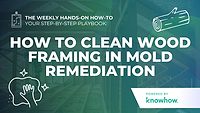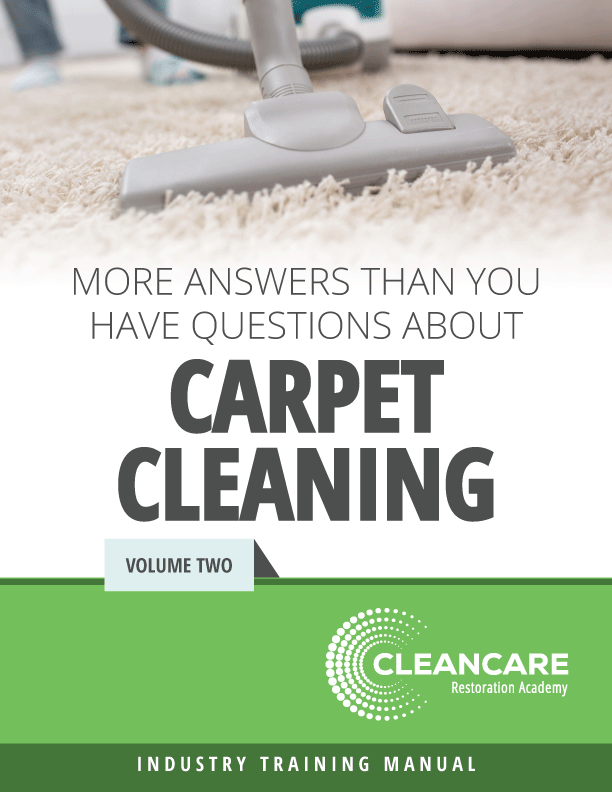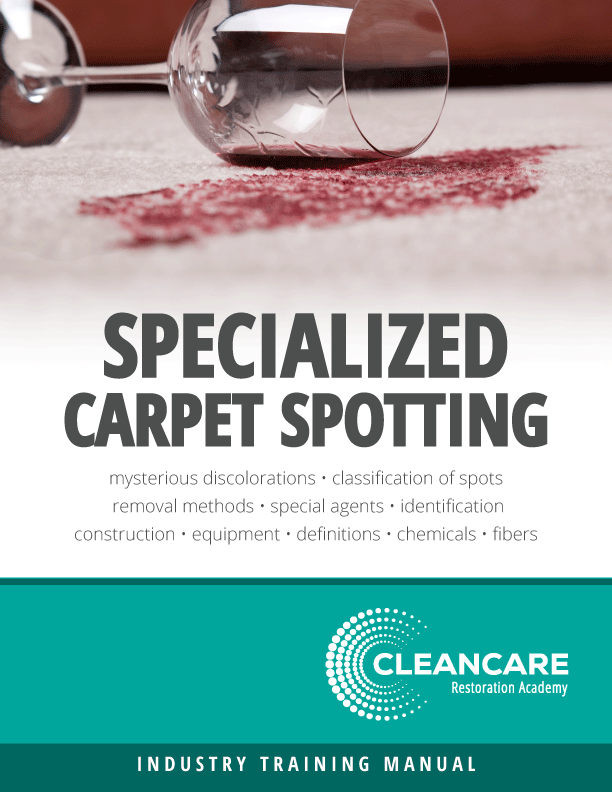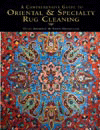Weekly Hands-on How-To powered by KnowHow
How To Clean Upholstered Furniture
Expert Tips for Upholstered Furniture Restoration: A Comprehensive Cleaning Guide

Whether it’s a red wine spill, cat marks, or just general grime from daily use, stained and dirty furniture can ruin the look of an otherwise beautiful space. Many homeowners will try to clean these messes themselves—only to end up making things worse. The wrong product or technique can cause colors to bleed, fabrics to weaken, or cause stains to set even deeper. That’s why homeowners often turn to restoration companies to save the day.
As a restorer, you have the opportunity to be a hero, using the right techniques to salvage furniture and save clients from the huge costs of replacements. With the proper approach, you can transform even the most damaged pieces into something beautiful, leaving your clients amazed. And that’s exactly what we’re going to cover in this article. In this weekly how-to, powered by KnowHow, we’ll guide you through the best practices for safely and effectively cleaning upholstered furniture.
So, get up off the couch, and let’s jump into the steps that will turn you into a furniture-cleaning pro.
Note: This Weekly Hands-On How-To is based on this template in KnowHow’s template library.
Step 1: Start with a Proper Pre-Inspection
A thorough pre-inspection isn’t just about spotting obvious stains or damage; it’s about understanding the current condition of the furniture so you can plan for any special treatments or precautions needed. By identifying potential issues at the start, you can prevent damage during cleaning and ensure a smoother process overall.
For more details, check out our guide on How to Complete a Furniture Pre-Cleaning Inspection

Step 2: Test All Fabrics for Colorfastness
Colorfastness refers to how well the fabric's colors hold up against external factors like washing, exposure to sunlight, or contact with various chemicals. Not all fabrics react the same way to cleaning products, so this is an essential test before proceeding. If a fabric is not colorfast, colors could bleed or fade during cleaning, an issue that is nearly impossible to fix.
Learn more in our How to Test for Colorfastness process.

Step 3: Select the Right Cleaning Products
Different fabrics and levels of soiling require different cleaning agents. Based on your pre-inspection and colorfastness tests, choose the appropriate cleaning products for the job. Plan for heavily soiled or stained areas to avoid complications later.
Step 4: Obtain Customer Consent
Always get the customer’s consent and walk them through your cleaning strategy before starting the cleaning process. This step is not only about getting the go-ahead but also about managing expectations. Discuss any potential risks, especially with heavily soiled or stained areas, and ensure they understand the possible outcomes of the cleaning process.
Step 5: Vacuum the Area to Be Cleaned
Now, it’s time to start the cleaning! Begin by thoroughly vacuuming the entire area to be cleaned. This process removes any loose dirt, dust, and debris, to prevent these particles from turning into mud during the wet cleaning process. Proper vacuuming will significantly improve the results of the following cleaning stages.
Step 6: Complete Initial Treatments
Apply any required pretreatments identified during the pre-inspection. This can include spot treatments for the heavily soiled or stained areas. Pretreating these spots allows the cleaning solution to penetrate and break down dirt more effectively during the deep cleaning phase.
Step 7: Get Ready for the Deep Cleaning
Now it’s time to get prepped for the deep cleaning. Typically, this involves using a water extraction upholstery cleaning machine. These machines inject hot water and a cleaning solution deep into the upholstery, releasing any embedded dirt and then extracting the water for quicker drying.

Step 8: Clean the Cushions First
Cushions usually hold the most dirt and stains, so it's best to start with them before cleaning the main frame of the furniture. This way, you can re-clean the cushions if necessary without disturbing the rest of the furniture or prolonging the process.
Follow these steps to ensure a thorough and effective cleaning process:
-
Prepare the Area: Place the cushions on a clean, protected surface, such as a drop cloth or work table, to prevent re-soiling.
-
Clean the Cushions: Move the extractor wand over the cushion in overlapping, gentle “zig-zag” strokes. Use stronger scrubbing strokes only on particularly dirty areas, but be careful not to over-wet the fabric or cause texture damage.
-
Clean Piping/Welt Cords: To clean these areas, use a towel dampened with detergent to gently remove built-up dirt or stains.
-
Dry the Cushions: Place the cleaned cushions in an inverted “V” shape (Like a pyramid), allowing air to circulate around them. To speed up the drying process, set a carpet dryer to blow through them.
- Avoid Re-soiling: Never place the wet cushions on the furniture platform, as the colors from the surface can bleed onto the cushions.
Step 9: Clean the Main Body of the Furniture
With the cushions cleaned and set aside, you can now focus on the main body of the furniture. The cleaning method will vary depending on the type of furniture and the extent of the soiling.
In general, follow these steps to ensure a thorough cleaning:
-
Outside Back and Arms: Start with these areas. If they appear clean, a light mist-and-vacuum approach will suffice. For heavily soiled spots, use the upholstery cleaning machine with standard cleaning strokes.
-
Kick Board and Skirt: Lay the furniture on its back and clean the kick board and front skirt. These areas often gather dust and dirt and may require more intensive cleaning.
-
Inside Back and Arms: Clean these areas from bottom to top to prevent streaking. If possible, keep the furniture in a horizontal position to maintain even pressure during cleaning.
- Top Arms and Seats: Finish by cleaning the top arms and seats, again working from the bottom up. Ensure you maintain gentle, overlapping strokes to avoid over-wetting the fabric.
Step 10: Inspect the Furniture
After cleaning, and when the furniture is dried, take a step back and inspect. Look for any remaining dirt or stains and repeat the cleaning process if needed. If additional cleaning is required, be cautious not to over-wet the fabric as excess moisture can lead to mold or mildew growth.
Step 11: Review the Work with the Customer
Finally, review the results with the customer. Discuss any problems encountered during the cleaning process, like stains that couldn’t be fully removed or any unexpected issues. This transparency helps build trust and reaffirms the clear expectations for the final outcome.
Start Cleaning Like a Pro With KnowHow
With these techniques, you can breathe new life into even the most stained and worn-out pieces of furniture. As we covered in this article, properly cleaning upholstered furniture is more than just scrubbing away stains—it’s about understanding how the fabrics will interact with products, and applying techniques that ensure long-lasting results.
But we all know that remembering every step and detail can be tough, especially if you’re new to the restoration space, or running from job to job. That’s where KnowHow comes in. With KnowHow, every restorer has the knowledge they need from day one. And when it’s time to put that training into practice, KnowHow’s step-by-step guides and tools provide instant access to company specific SOPs, keeping your crew confident and equipped in any situation.
Take the guesswork out of your restoration projects and impress your clients on every job. Visit tryknowhow.com to learn how KnowHow can help you deliver consistent, top-notch results every time.
Looking for a reprint of this article?
From high-res PDFs to custom plaques, order your copy today!


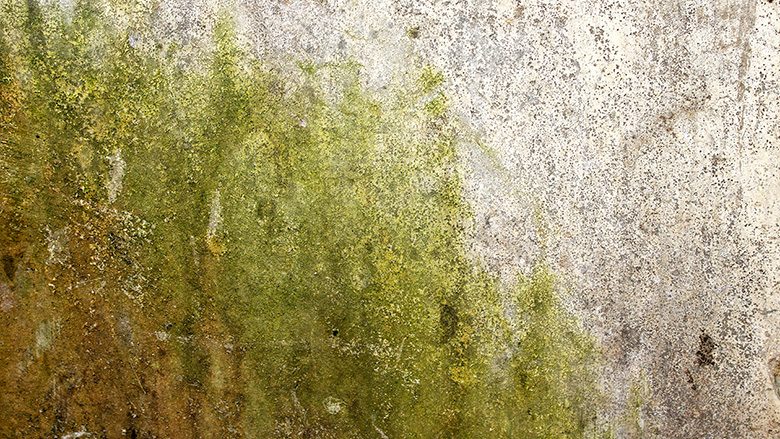
.jpg?height=200&t=1729002037&width=200)
